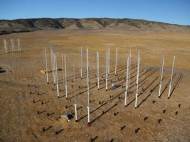New results for vertical-axis wind turbines inspired by fish schooling
 last year we wrote about a group of researchers at the California Institute of Technology (Caltech) who have been conducting a field study at an experimental two-acre wind farm in northern Los Angeles County. In their new findings, the researchers came up with a way to increase the power output of wind farms simply by optimizing the placement of turbines on a given plot of land.
last year we wrote about a group of researchers at the California Institute of Technology (Caltech) who have been conducting a field study at an experimental two-acre wind farm in northern Los Angeles County. In their new findings, the researchers came up with a way to increase the power output of wind farms simply by optimizing the placement of turbines on a given plot of land.
Led by John Dabiri, Caltech professor of aeronautics and bioengineering at Caltech, the researchers built the Field Laboratory for Optimized Wind Energy (FLOWE) – an experimental farm which houses 24 vertical-axis wind turbines (VAWTs). Each turbine is 10 meters (nearly 33 feet) tall and 1.2 meters (nearly 4 feet) wide.
Unlike the horizontal-axis wind turbines (HAWTs), where individual turbines have to be spaced far apart, VAWTs can be placed relatively close to each other and be stacked on several vertical levels. The ability to be positioned very close to one another lets them capture nearly all of the energy of the blowing wind and even wind energy above the farm.
Although winds at lower altitude blow far less energetically, according to Dabiri, the global wind power available 10 meters (30 feet) off the ground is several times greater than the world’s electricity usage. That means that enough energy can be obtained with smaller, cheaper, less environmentally intrusive turbines – as long as they’re the right turbines, arranged in the right way.
In the summer 2010 field tests, Dabiri and his colleagues measured the rotational speed and power generated by each of the six turbines when placed in a number of different configurations. Dabiri got the idea to make every turbine turn in the opposite direction of its neighbors from his studies of schooling fish. The opposing spins decrease the drag on each turbine, allowing them to spin faster and increasing their efficiency.
Their new findings showed that an arrangement in which all of the turbines in an array were spaced four turbine diameters apart (4.8 meters, or approximately 16 feet) completely eliminated the aerodynamic interference between pairs of neighboring turbines.
“We’re on the right track, but this is by no means ‘mission accomplished'”, said Dabiri. “The next steps are to scale up the field demonstration and to improve upon the off-the-shelf wind-turbine designs used for the pilot study.”
For more information, you can read the article published in the Journal of Renewable and Sustainable Energy named: “Potential order-of-magnitude enhancement of wind farm power density via counter-rotating vertical-axis wind turbine arrays” (preprint PDF).









Good Study on Spacing of VAWT(Vertical Axis Wind Turbine).
Not only that by placing Upwind and Downwind turbines in the same wind farm precious windy area can be conserved. In a upwind turbine wind strikes the blades first while in a downwind turbine,wind strikes the tower first.
Dr.a.Jagadeesh Nellore(AP),India
wind energy Expert
E-mail: anumakonda.jagadeesh@gmail.com